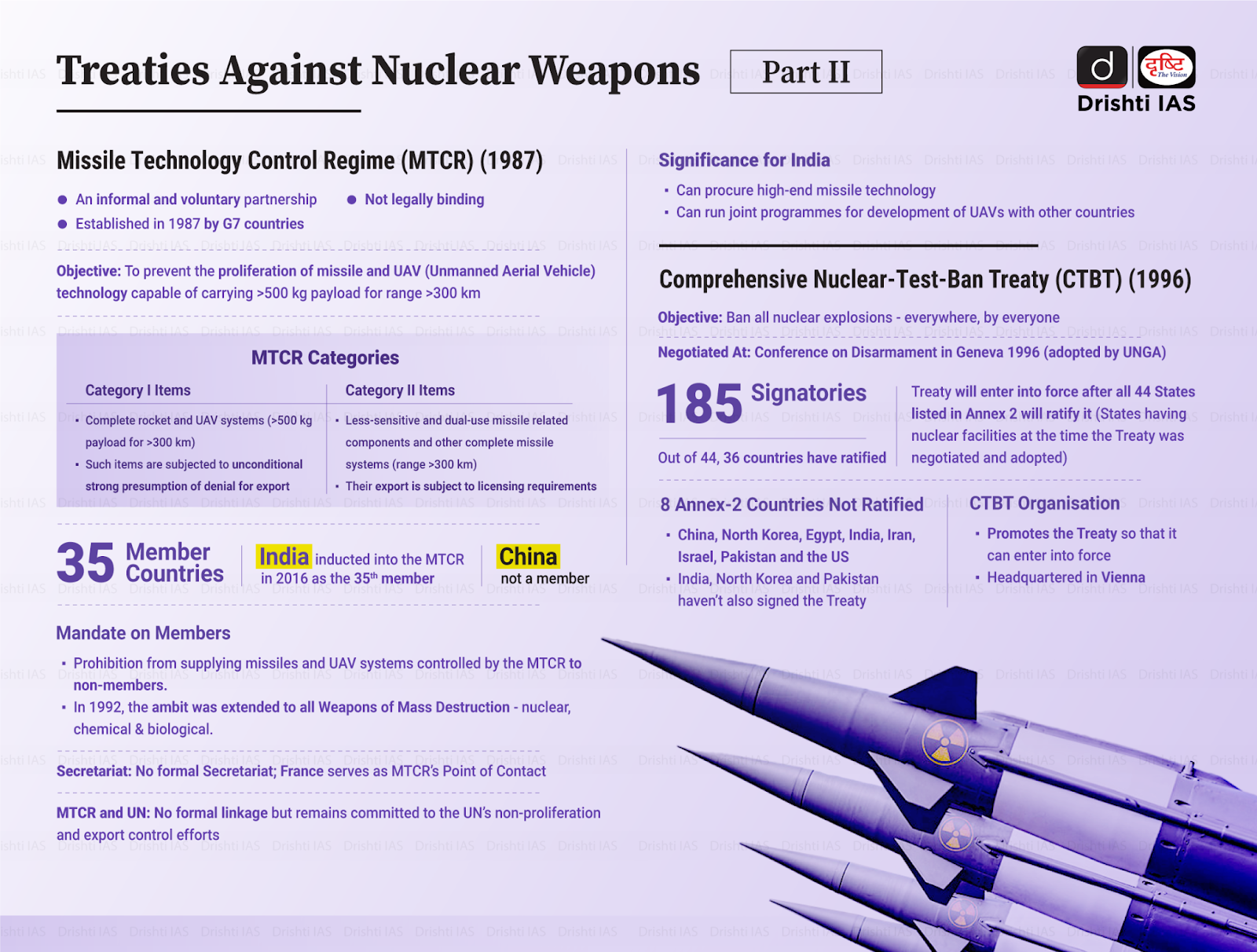Important Facts For Prelims
Comprehensive Nuclear Test Ban Treaty
- 13 Oct 2023
- 5 min read
Why in News?
Russia has recently indicated that it is moving towards revoking its ratification of the Comprehensive Nuclear Test Ban Treaty (CTBT).
What is the Comprehensive Nuclear Test Ban Treaty (CTBT)?
- Genesis of the CTBT:
- The CTBT is a multilateral treaty aimed at banning all nuclear explosions, whether for military or peaceful purposes.
- The roots of the CTBT can be traced back to the Cold War era when the United States and the Soviet Union were engaged in a nuclear arms race, conducting numerous nuclear tests.
- Between 1945 and 1996, over 2,000 nuclear tests took place globally, with the U.S. conducting 1,032 tests and the Soviet Union conducting 715 tests, among others.
- In response to concerns about the environmental and health impacts of nuclear tests, the international community made efforts to limit testing.
- The Limited Nuclear Test-Ban Treaty (LTBT) of 1963 prohibited nuclear testing in the atmosphere, outer space, and underwater but allowed underground tests.
- The Threshold Test Ban Treaty (TTBT) of 1974 prohibits underground nuclear weapons tests and establishes a nuclear "threshold," yet it falls short of providing a comprehensive ban on all nuclear testing.
- Breakthrough with the CTBT:
- The end of the Cold War and the dissolution of the Soviet Union created a conducive environment for comprehensive arms control measures.
- The CTBT was negotiated at the Conference on Disarmament in Geneva in 1994.
- In 1996, the United Nations adopted the CTBT, which imposed a complete ban on nuclear weapons testing, closing the gaps left by previous treaties.
- The CTBT became available for signature in September 1996, signifying a major advancement in the global endeavour to halt nuclear testing across the world.
- The CTBT will enter into force 180 days after it has been ratified by all 44 states listed in Annex 2 to the treaty, which are states that possessed nuclear reactors or research reactors at the time of its adoption.
- Current Position:
- It has been signed by 187 nations and ratified by 178. However, the treaty cannot formally enter into force until it is ratified by 44 specific nations. Eight of these nations have yet to ratify the treaty:
- China, India, Pakistan, North Korea, Israel, Iran, Egypt, United States.
- It has been signed by 187 nations and ratified by 178. However, the treaty cannot formally enter into force until it is ratified by 44 specific nations. Eight of these nations have yet to ratify the treaty:
UPSC Civil Services Examination, Previous Year Questions (PYQs)
Prelims
Q. What is/are the consequence/consequences of a country becoming the member of the ‘Nuclear Suppliers Group’? (2018)
- It will have access to the latest and most efficient nuclear technologies.
- It automatically becomes a member of “The Treaty on the Non-Proliferation of Nuclear Weapons (NPT)”.
Which of the statements given above is/are correct?
(a) 1 only
(b) 2 only
(c) Both 1 and 2
(d) Neither 1 nor 2
Ans: (a)
Q. Consider the following countries: (2015)
- China
- France
- India
- Israel
- Pakistan
Which among the above are Nuclear Weapons States as recognized by the Treaty on the Non-Proliferation of Nuclear Weapons, commonly known as Nuclear Non-Proliferation Treaty (NPT)?
(a) 1 and 2 only
(b) 1, 3, 4 and 5 only
(c) 2, 4 and 5 only
(d) 1, 2, 3, 4 and 5
Ans: (a)
Mains
Q. In what ways would the ongoing U.S-Iran Nuclear Pact Controversy affect the national interest of India? How should India respond to this situation? (2018)
Q. With growing energy needs should India keep on expanding its nuclear energy programme? Discuss the facts and fears associated with nuclear energy. (2018)
Q. Give an account of the growth and development of nuclear science and technology in India. What is the advantage of fast breeder reactor programme in India? (2017)








